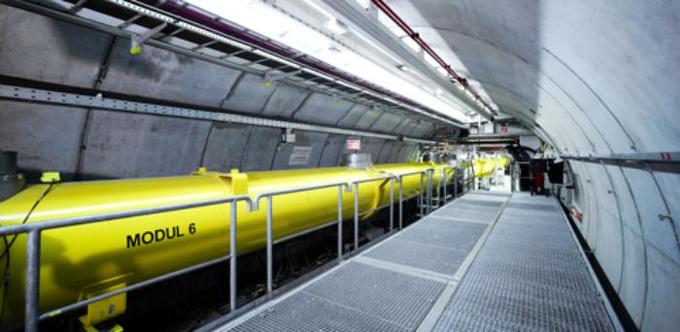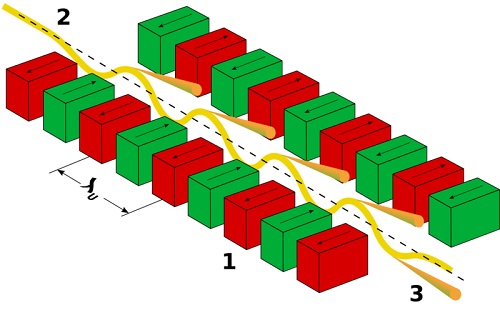What is a FEL

When fast electrons at nearly the speed of light cross a magnetic field on their way, they are deflected and generate bright, well collimated light tangentially to their curved path. This was first observed on a General Electric synchrotron accelerator in 1947 and the light was called synchrotron radiation. For decades, scientists have been employing this effect to produce high-intensity radiation in a wide spectral range from the far infrared to hard X-rays for research purposes. Modern synchrotron radiation sources do not use single magnets to generate the light, but a series of tens (or even hundreds) of magnets with alternating field, called undulator, in which the electron beam wiggles (“undulates”) only slightly about a straight line. In each curve, the electrons generate light which overlaps and interferes constructively for certain wavelengths leading to nearly monochromatic light emitted in a narrow cone. This is illustrated schematically in the figure below.
The Free Electron Laser (FEL) makes use of the physics of the undulator. In 1970 John Madey showed in his PhD thesis that an undulator can amplify resonant radiation. He calculated that “finite gain is available from the far-infrared through the visible region raising the possibility of continuously tunable amplifiers and oscillators at these frequencies with the further possibility of partially coherent radiation sources in the ultraviolet and X-ray regions to beyond 10 keV”. The first IR FEL was realised in his laboratory at Stanford University, USA, a few years later. A number of FEL facilities were then built all over the world, some of them integrated in electron storage rings. They all made use of optical cavities to amplify the radiation in many round trips. Unfortunately, this concept does not work for the extended ultraviolet and X-ray region because high-reflectivity mirrors at normal incidence are not available.
In order to produce X-rays, a different concept is used: The undulator is made very long and a much better quality electron beam in terms of density and emittance is generated in order to achieve amplification up to saturation in a single pass. The spontaneous undulator radiation generated in the first part of the undulator interacts with the electron beam and eventually modulated its density such that millions of electrons radiate in phase, leading to a tremendous gain and ultrashort pulses, orders of magnitude more powerful than what all other types of X-ray sources produce.
Schematic representation of an undulator. 1: magnets, 2: electron beam entering from the upper left, 3: laser light exiting to the lower right. The amplitude of the wavelike electron path is exaggerated, in practice it is only a few micrometers such that the radiation cones overlap and interfere. Since the generated light is slightly faster than the electrons, constructive interference occurs when the light wave slips forward by one wavelength λ1 for each period of the electron path, i.e. the undulator period λu. The output wavelength depends on the electron energy and the strength of the magnetic field; both parameters can be used to tune the radiation wavelength continuously over a wide spectral range.

